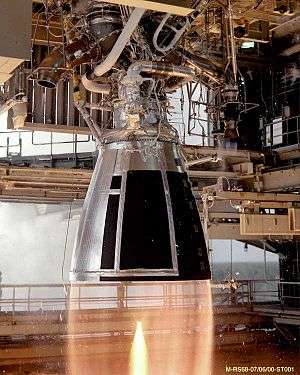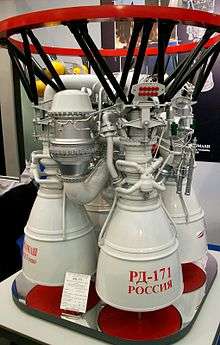RD-191
The RD-191 is a high performance single-combustion chamber rocket engine, developed in Russia. It is derived from the RD-180 dual-combustion chamber engine, which itself was derived in turn from the four-chamber RD-170 originally used in the Energia launcher.
| Country of origin | |
|---|---|
| Date | 2001 |
| Designer | NPO Energomash |
| Manufacturer | NPO Energomash / Proton-PM (in transition) |
| Application | Main engine |
| Predecessor | RD-170 |
| Status | In use |
| Liquid-fuel engine | |
| Propellant | LOX / RP-1 |
| Mixture ratio | 2.6 |
| Cycle | Oxidizer-rich Staged combustion |
| Configuration | |
| Nozzle ratio | 37:1 |
| Performance | |
| Thrust (vac.) | 2.09 MN (470,000 lbf) at 100% throttle |
| Thrust (SL) | 1.92 MN (432,000 lbf) at 100% throttle |
| Throttle range | 27–105% |
| Thrust-to-weight ratio | 89 |
| Chamber pressure | 25.8 MPa (3,740 psi) |
| Isp (vac.) | 337 s (3.30 km/s) |
| Isp (SL) | 310.7 s (3.047 km/s) |
| Burn time | 325 s (Angara A5 core stage) |
| Gimbal range | 8° |
| Dimensions | |
| Length | 4 m (160 in) |
| Diameter | 1,45 m (57 in) |
| Dry weight | 2,290 kg (5,050 lb) |
| References | |
| References | [1][2] |
The RD-191 is fueled by a kerosene / LOX mixture and uses an oxygen-rich staged combustion cycle. In the future the engine is expected to become a workhorse in the Russian space sector, as older launch vehicles are phased out of production and service.
Design
Burn ignition is provided chemically, by feeding a starter fluid into the combustion chamber and gas generator which is self-igniting on contact with liquid oxygen. The engine is capable of throttling down to 30% of nominal thrust; the design also allows for a short-duration enhanced thrust (up to 105% of nominal level) in emergency situations. A Cardan suspension provides for yaw and pitch controls by gimballed thrust deflection up to 8 degrees.
A modern design, the engine incorporates sensors monitoring burn conditions. The measurements are used for telemetry and an emergency protection system.
The engine's powerhead fulfills two additional functions, heating helium gas for pressurization of propellant tanks and generating hydraulic power for hydraulic actuators to deflect the nozzle and aerodynamic rudders.
Development
On 5 September 2008, the creator of the engine, NPO Energomash, stated that the engine had completed the full cycle of development and burn tests and is ready for manufacturing and delivery.[3] The primary launch vehicle utilizing this engine is the Angara rocket, currently being developed.[4]
As of 2010, the engine had passed all development phases and its nine prototypes had accumulated over 23,000 seconds in 105 firing tests, with one of them reaching the maximum running time of 3,635 seconds in 12 tests. Interdepartmental tests are under way and manufacturing of the engines for flight development tests has started. The flight tests will begin with a launch of the Angara-1.2 light-class rocket, and then of the Angara-A5 heavy launcher. Despite problems with funding, work on the RD-191 engine is in line with the Angara rocket family's master schedule.[5]
Variants
RD-151
A version of the RD-191 with thrust reduced to 170 tonnes, called RD-151, was fire-tested on July 30, 2009. The first flight test of this engine was conducted on 25 August 2009 as part of the first launch of South Korean Naro-1 rocket.[6][7]
RD-181
The RD-181 is based on the RD-191 and is adapted for integration on the Antares rocket. While the RD-193 was designed as a close replacement for the NK-33, on December 17, 2014, Orbital Sciences announced that it would use the NPO Energomash RD-181 on the version 2 Antares launch vehicle and had contracted directly with NPO Energomash for up to 20 RD-181 engines.[8] Two engines are used on the first stage of each Antares, which is currently used to carry cargo to the International Space Station under contract to NASA.[9] While Russian press had stated that the contract was valued at US$ 1 billion with options, Orbital stated on 26 January 2015 that even when exercising all the options the contract was less than that amount, and that the initial contractual commitment was significantly less than that. On 19 February 2015, Orbital ATK said that its revamped Antares rocket featuring a new main engine would make its first launch in March 2016. On 29 May 2015, Orbital stated that the new engines had successfully conducted seven certification firings and all went as expected. It also stated that the first two flight models were doing its final tests and would be delivered to Orbital in early July.[10][11][12][13][14][15]
The two RD-181s have 440 kilonewtons (100,000 lbf) more thrust than the paired AJ-26 engines used on the first generation Antares. Northrop Grumman Innovation Systems (formerly Orbital) modified the core stage to accommodate the increased performance, and then to finish up its CRS-1 cargo contract commitment to NASA for delivering a total of 20,000 kg (44,000 lb) of cargo in only four additional flights, rather than the five more that would have been required with the AJ-26/Antares I combination.
For the Antares 230+ upgrades, debuted with the CRS-2 Cygnus NG-12 mission, heat exchangers were removed from the RD-181 engine.[16] [17]
RD-193
In April 2013, it was announced that a further derivation, the RD-193, had completed testing. This version is lighter and shorter, designed for use on the light-launcher Soyuz-2.1v when the inventory of surplus NK-33 engines is exhausted.[18]
See also
References
- "Archived copy". Archived from the original on 2011-11-11. Retrieved 2011-12-26.CS1 maint: archived copy as title (link) RD-191 Rocket Engine
- "Angara 1.2". Spaceflight101. Retrieved 2015-06-30.
- "A new engine is ready for Angara (in Russian)". 2008-09-05.
- "Successful Tests of Angara Stage 1 Engine". Khrunichev. 2007-12-12. Archived from the original on 2007-12-30.
- Chvanov, Vladimir (2010). "Russia's liquid rocket enginges are unrivalled". Military Parade (2): 40–41.
- "First launch of KSLV-1 is conducted". 2009-08-25.
- "S. Korea to launch first space rocket on Aug. 19". 2009-08-25.
- "ГОДОВОЙ ОТЧЕТ ОАО «НПО «Энергомаш» за 2014 год. page 20". «НПО «Энергомаш». 2015. Archived from the original on 2016-10-31.
- Morring, Frank, Jr. (16 December 2014). "Antares Upgrade Will Use RD-181s In Direct Buy From Energomash". Aviation Week. Retrieved 28 December 2014.
- Zak, Anatoly. "RD-181". russianspaceweb.com. Retrieved 2015-06-04.
- Selding, Peter B. "Orbital Sciences Orders RD-181 Engines for Antares Rocket". SpaceNews. Retrieved 2015-06-04.
- Selding, Peter B. "Orbital Sciences: Russian Press Overstate RD-181 Contract Value". SpaceNews. Retrieved 2015-06-04.
- Selding, Peter B. "Re-engined Antares To Carry Space Station Cargo in 2016 Debut". SpaceNews. Retrieved 2015-06-04.
- Selding, Peter B. "Orbital ATK Sees Commercial Satellites as Top Growth Area". SpaceNews. Retrieved 2015-06-04.
- Афанасьев И. (2012). ""Энергомаш" в новом тысячелетии" (PDF). News of Cosmonautics. 8 (22).
- Clark, Stephen. "Space station resupply mission successfully launches from Virginia". Spaceflight Now. Retrieved 2 November 2019.
- "Antares Users Guide, Release 3.0" (PDF). Northrop Grumman. August 2018. Retrieved 2019-11-03.
- "New engine for light rocket "Soyuz" prepare for mass production at the end of the year" (in Russian). Новости космонавтики. Retrieved 8 April 2013.
External links
| Wikimedia Commons has media related to RD-191. |
- "RD-191". Energomash. Archived from the original on 2014-07-05.

